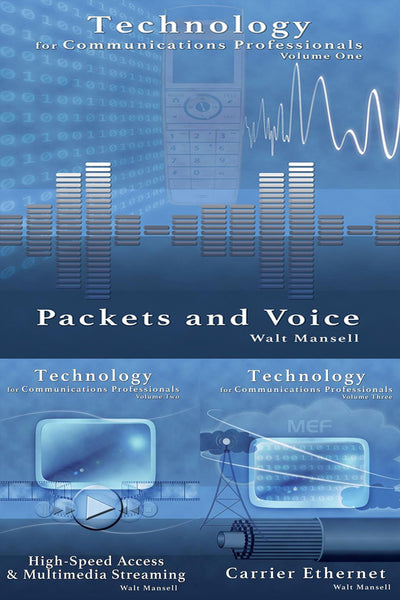Technology for Communications Professionals, Three-Volume Set
$150.00
The first volume in this series is called "Packets and Voice." This book examines the basic structure of packet networks. We discuss packet structure and addressing as well a discussion of routers, routing systems, and an introduction to Quality of Service functions. Part two of this book examines Voice over IP. We discuss voice sampling, quantization, and various issues encountered when supporting voice services over a packet network. We encourage all to focus and complete the exercise questions. The answers are in the back of the book. The time required to complete those questions is minimal and they help you determine your understanding of the topics.
The second volume in the Technology for Communications Professionals set is entitled "High-Speed Access and Multimedia Streaming." This volume examines the local loop access technologies to raise the bandwidth requirements of today's communications network in support of multimedia services. We discuss DSL options and passive networks. In the second part of this book, we examine compression and quality of service techniques to support the simultaneous delivery of voice, data and video streams over the local loop network. We encourage all to focus and complete the exercise questions. The answers are in the back of the book. The time required to complete these questions is minimal and they help you determine your understanding of the topics.
Volume III in the set is entitled, "Carrier Ethernet." Ethernet, the LAN technology, is the universally accepted technology deployed on all public and private data networks. The migration from the legacy telecom and Cable TV networks is towards a single network capable of supporting all voice, video and data services over a single interface (wire). The service platform to support these services is Carrier Ethernet. The customer interface for the next generation network is Ethernet. You could in-fact consider Ethernet as the new dial-tone for the next generation network. Carrier Ethernet incorporates Ethernet LAN technology as the foundation to build the services platform. Carrier Ethernet provides the service provider with a ability to offer customers a range of granular services which can be uniquely tailored to the customer's requirements.
In addition, Carrier Ethernet gives the service provider the means to control performance, provides a maintenance model, and defines the structure to enable accurate billing for such services. It's a big win for the customer as no new equipment is required to work with their existing LAN equipment. For the service provider the Carrier Ethernet equipment is less expensive to purchase, deploy, and maintain. The last point to establish is that Carrier Ethernet is a collaborative technology. In many cases service providers may not have the network footprint to support all of their customers' locations. In such cases the service provider who "owns" the customer must rely on network operator partners to maintain the required customer service for their clients. All service providers and network operators should be on board and fully support Carrier Ethernet services and functions to participate in this market. All job functions within the service provider organization should understand the basic concepts and functions of Carrier Ethernet to apply their particular expertise and maximize the value they bring to the mission of the organization.
Related Items


Blue Pelican Java
$43.95
Author: Charles E. Cook ISBN 1-58939-758-4 (softcover) 544 Pages "Blue Pelican Java" is a somewhat unusual...


Cumulative Impact and Other Disruption Claims in Construction
$75.00
Authors: Richard J. Long, Rod C. Carter, and Harold E. Buddemeyer ISBN 978-1-62137-527-2 (hardcover) ISBN 978-1-62137-739-9...


Journey Toward Energy Independence
$25.95
Author: Harry Johnson ISBN 978-1-621-37987-4 (hardcover) 150 Pages BOOK DESCRIPTION For 150 years, conventional...






